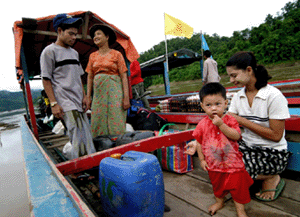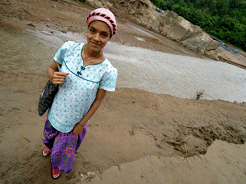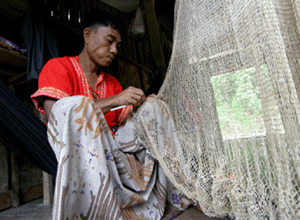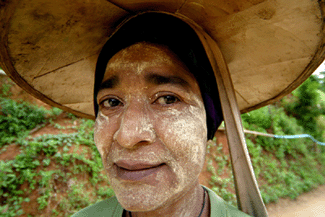While over the years the US and other western countries have slapped Myanmar with strict economic sanctions, during his time in office Thailand’s ousted Prime Minister Thaksin Shinawatra tended to stress closer economic ties with Myanmar’s reclusive regime vs. the more isolationist approach of previous Thai governments – a policy that often brought down harsh criticism from abroad.
Despite Mr. Piyasvasti’s vows to scrap the Salween hydro projects, preparations for the dams continue and many observers believe that planning for at least two of the proposed dams, at Hat Gyi and Tasang, could be too far advanced to simply put construction on hold, with or without Thai participation. Indeed, Piyasvasti accompanied interim Prime Minister Surayud Chulanont on an official visit to Myanmar in late November to discuss development of the first dam at Hat Gyi in Karen State.
 Thailand is one of the most foreign oil dependent countries in Asia and with its own hydro capacity almost maxed-out, Thailand is desperately seeking alternative energy sources, particularly in neighboring countries like Laos and Myanmar. With large, unknown sums of money already being poured into the development of the dams, it is unclear whether or not Thailand will simply be able to back out of the Salween damming projects.
Thailand is one of the most foreign oil dependent countries in Asia and with its own hydro capacity almost maxed-out, Thailand is desperately seeking alternative energy sources, particularly in neighboring countries like Laos and Myanmar. With large, unknown sums of money already being poured into the development of the dams, it is unclear whether or not Thailand will simply be able to back out of the Salween damming projects.
If built, the five dams along the Salween could cost over US$10 billion and would have the combined potential to produce 10,000-15,000 megawatts of power. Projections estimate that Thailand could have received as much as 85-90% of the energy generated by the Salween dams.
Significantly, the dams would also provide a desperately needed source of income for Myanmar, a country controlled by a harsh military government which is often criticized for its poor human rights record.
Controversial Dam Sites
 The 2,800km-long Salween River is Southeast Asia’s longest free-flowing waterway, and over the years the proposed hydro projects have stirred up a firestorm of controversy among both environmental and human rights groups.
The 2,800km-long Salween River is Southeast Asia’s longest free-flowing waterway, and over the years the proposed hydro projects have stirred up a firestorm of controversy among both environmental and human rights groups.
One of the principal reasons is that several of the dams are planned for areas still hotly contested by armed ethnic insurgent groups, some of which have been fighting for autonomy in Myanmar for more than 50 years. During its military campaigns over the years in Shan, Karen and Karenni States, Myanmar’s State Peace and Development Council (SPDC) has been accused of a wide range of human rights abuses including forcible relocations, slave labor and extrajudicial killings.
Recently the SPDC has intensified its military offensives against Karen guerrillas near the proposed dam sites, sparking wide-spread condemnation from international rights groups.
"In terms of the offensives, this is quite clear," said David Scott Mathieson, a research consultant with US-based Human Rights Watch. "The current offensives have to do with [the] dams, as did the Shan forced relocation campaign between 1996 and 1998. The best way to [see] this is to place maps of proposed dam sites next to maps of the offensives and previous campaigns. The SPDC is clearing people away from development sites."
 The first dam, which is to be built with Chinese funding at a cost of over US$1 billion near Hat Gyi in Karen State, is scheduled to begin ground-breaking in November 2007. That gives the SPDC a one-year window to flush out Karen guerrillas and forcibly secure the area.
The first dam, which is to be built with Chinese funding at a cost of over US$1 billion near Hat Gyi in Karen State, is scheduled to begin ground-breaking in November 2007. That gives the SPDC a one-year window to flush out Karen guerrillas and forcibly secure the area.
Meanwhile, reports have already emerged of incidents of forced relocation and labor, rape and extrajudicial killings – as well as the torching of nearby villages and the laying of mines. Surveying for the 1,200-megawatt Hat Gyi Dam was actually halted earlier this year after an EGAT employee, Chana Mongplee, was killed May 9 after stepping on a land mine.
The US$6 billion Tasang Dam, if completed, could generate up to 7,110 megawatts of power and, at 228 meters, it would be the tallest dam in Southeast Asia. The dam site, however, is in a highly militarized area where as many as 300,000 Shan villagers have been forcibly displaced since 1996.
Mathieson is quick to point out that the "dams are not the only reason for the offensives, but one of many, including cutting off civilian support for Karen insurgents, actually destroying Karen infrastructure, plus general militarization to pursue road construction and other economic ventures such as mines and agri-projects".
The Human Impact
The United Nations High Commissioner for Refugees (UNHCR) reports that over a three-month period earlier this year, at least 2,000 Karen fled across the border into Thailand during the junta’s intensified military operations. The Thailand-based Karen Human Rights Group (KHRG) reports that another 20,000 people have been forced to flee their villages and seek refuge in the diminishing areas inside Myanmar controlled by the armed Karen National Union (KNU) insurgent group.
"Access roads are being built near dam sites. Often villagers are forcibly relocated from one area and then used as forced labor," said a KHRG spokesperson, who also alleges that relocated people are being used to clear forest areas and build access roads to newly established SPDC camps in areas near the dam sites.
 Pianporn Deetes, spokesperson for the Salween Watch Coalition, an umbrella group monitoring the situation, said the biggest worry is the potential human impact of the dams. "On the Thai side of the border there are at least 50 small communities that will have to be relocated. In Karen state over 35,000 will be displaced and another 30,000 in Karenni state."
Pianporn Deetes, spokesperson for the Salween Watch Coalition, an umbrella group monitoring the situation, said the biggest worry is the potential human impact of the dams. "On the Thai side of the border there are at least 50 small communities that will have to be relocated. In Karen state over 35,000 will be displaced and another 30,000 in Karenni state."
The Salween, which originates in the Tibetan Plateau and snakes its way through China, Myanmar and Thailand, is widely recognized as one of the most diverse biological environments in the world. Part of the Three Parallel Rivers area, the Salween was named a World Heritage Site in 2003 and is home to more than 7,000 species of plants and 80 rare or endangered fish and animals.
In April 2004, China postponed its own plans to build 13 dams along the upper reaches of the Salween – called the Nu River in China – after intense lobbying by Chinese NGOs and prominent academics.
In military-ruled Myanmar however it is highly unlikely that similar voices of dissent would ever have been heard. While on-site preparations for the dams move forward – and SPDC offensives intensify – the fate of the Salween and its people floats precariously in the balance.
All photos by Will Baxter.
